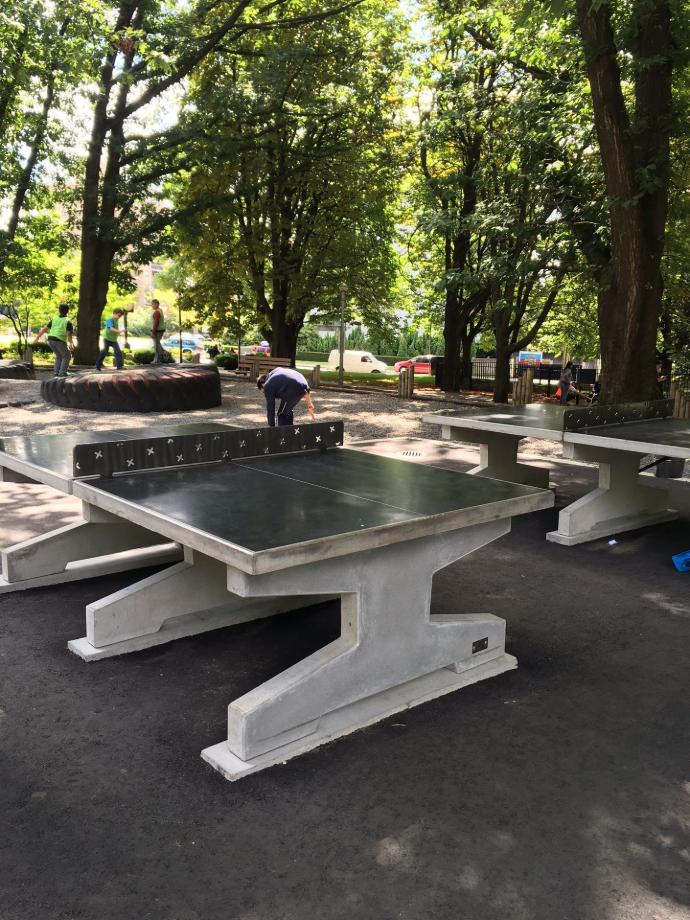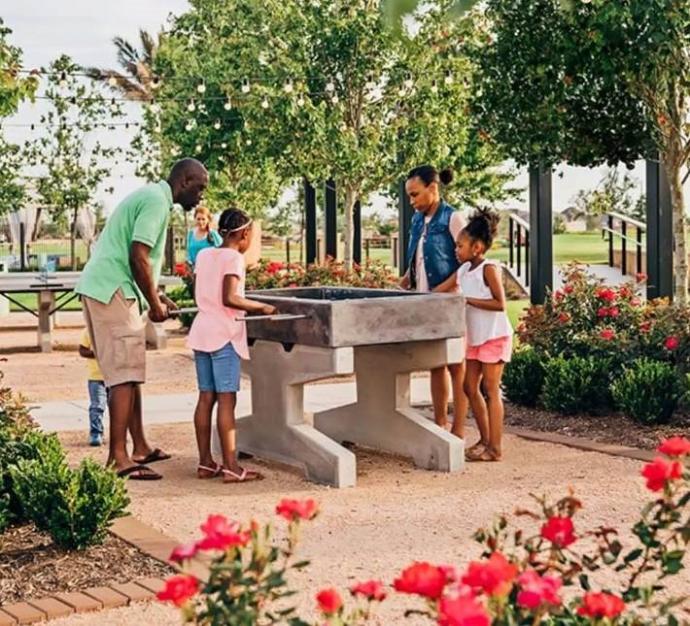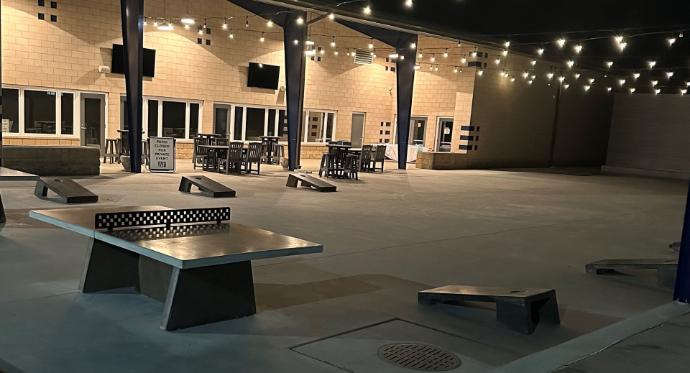A New Era for Parks and Public Spaces
Public space design in 2025 is about more than aesthetics. It’s about activation, turning underused or overlooked areas into vibrant centers of community life. This shift in placemaking, is a design approach popularized by Project for Public Spaces (PPS), which emphasizes that the best places aren’t simply built, they are nurtured through human interaction, inclusivity, and a sense of belonging.
At every scale whether a pocket park tucked into a neighborhood, a community park serving families, or a regional destination park the goal is the same: to create outdoor spaces that feel like community centers.
Pocket Parks: Small Scale, Big Impact

Pocket parks are a key trend in 2025. They take advantage of small, overlooked parcels of land—alleyways, vacant lots, street corners—and transform them into touchpoints for community life.
The genius of pocket parks lies in their ability to make a big impact with modest interventions. Adding a pair of concrete ping pong tables or a concrete foosball table can instantly change the dynamics of a block. Parents walking home from school linger while children play. Teenagers gather for friendly competition. Neighbors stop to watch and end up striking up conversations.
In this way, a pocket park becomes not just a recreational stop, but a social catalyst. As PPS puts it, “Lighter, quicker, cheaper interventions often have the most lasting impact.” Durable, weatherproof concrete game tables perfectly embody this principle—they require no maintenance, welcome spontaneous play, and endure for decades.
Neighborhood Parks as Outdoor Living Rooms
Neighborhood parks, slightly larger in scale, are evolving in 2025 into what some designers call “outdoor living rooms.” These are spaces where people don’t just pass through—they stay, gather, and return often.

Neighborhood parks, slightly larger in scale, are evolving in 2025 into what some designers call “outdoor living rooms.” These are spaces where people don’t just pass through—they stay, gather, and return often.
Instead of one large playground or athletic field, the trend is toward clusters of interactive amenities that appeal across generations. A well-designed neighborhood park may include:
- Concrete chess tables where seniors mentor students or strangers bond over strategy.
- Concrete cornhole boards that invite casual, drop-in fun.
- Concrete foosball tables where small groups gather for fast-paced energy.
- Ping pong tables that serve as magnets for social play.
By combining these timeless games into a collection, neighborhood parks become outdoor community centers—flexible spaces where every visit feels different, and every person finds a way to connect.
This design philosophy echoes the NRPA (National Recreation and Park Association) research, which shows that parks are most successful when they provide multi-generational, low-barrier activities that encourage both recreation and social interaction.
Big Parks: Multi-Zone Placemaking

Larger regional and destination parks are not exempt from these design shifts. In fact, 2025 is seeing a strong move away from vast, undefined lawns and toward multi-zone placemaking.
Larger regional and destination parks are not exempt from these design shifts. In fact, 2025 is seeing a strong move away from vast, undefined lawns and toward multi-zone placemaking.
Big parks are now designed as a series of “rooms” or “districts” within the larger landscape:
- Active play areas with durable, permanent games.
- Shaded plazas for rest, reflection, and conversation.
- Cultural spaces for performance and art.
- Food courts or vendor areas that sustain long visits.
In these spaces, concrete games serve as anchors. A set of ping pong and foosball tables doesn’t just provide play—they define a zone. Families gravitate toward them. Visitors hear laughter and are drawn in. What could otherwise be empty hardscape becomes a living, human-scaled destination.
Case Study 1: U.N. Plaza, San Francisco
U.N. Plaza has long been one of San Francisco’s most challenging public spaces. Surrounded by civic buildings and transit hubs, it suffered from decades of neglect, with high rates of homelessness, drug use, and safety concerns driving families and workers away.
In 2023, the city embarked on an urban repair effort—a bold attempt to reclaim the plaza for everyday community life. Among the interventions were the installation of Stone Age Concrete Games: ping pong, foosball, and cornhole.
The results were immediate. The tables provided low-barrier entry points for play and interaction. Instead of being dominated by negative activity, parts of the plaza became lively hubs where workers on lunch break, students after school, and passersby all gathered around games.
This illustrates a critical point: in urban plazas where challenges are deeply entrenched, interactive amenities can act as “positive anchors”. They don’t solve systemic issues alone, but they create islands of activation that shift the feel of the space.
Case Study 2: Yanaguana Garden, San Antonio
On the opposite end of the spectrum is Yanaguana Garden at Hemisfair Park in San Antonio, Texas. Opened in 2015, this 4.1-acre garden was part of a visionary project to turn Hemisfair into a world-class urban park district.
Here, the goals were different from U.N. Plaza. Yanaguana was not about repairing dysfunction—it was about building a destination. Its design drew on the Payaya Indians’ creation story of the San Antonio River, weaving art, play, and culture into the landscape.
Stone Age contributed two ping pong tables, two foosball tables, two concrete cornhole sets, and two custom concrete chess tables with translucent Mardi Gras glass inlays. These pieces were not afterthoughts but central to the park’s identity—helping establish Yanaguana as a place where families, tourists, and locals alike come for joyful play.
Today, Yanaguana Garden is one of San Antonio’s most beloved attractions, showing how durable, playful infrastructure can elevate a park into a cultural icon.
Lessons From the Case Studies
Together, U.N. Plaza and Yanaguana Garden highlight the two faces of public space design in 2025:
-
Urban Repair (U.N. Plaza)
- Goal: Counter negative activity, reintroduce positive social behaviors.
- Strategy: Use rugged, low-barrier amenities (ping pong, foosball, cornhole) to spark everyday activation.
- Lesson: Small interventions can create safe, welcoming footholds in difficult environments.
-
Destination Building (Yanaguana Garden)
- Goal: Create a cultural, family-friendly landmark.
- Strategy: Integrate interactive play (custom chess, ping pong, foosball, cornhole) into a larger artistic and storytelling framework.
- Lesson: When woven into the design vision, concrete games become signature attractions.
These case studies underscore a truth at every scale: play activates space. Whether repairing or building anew, interactive concrete games invite people to claim the space as their own.
Placemaking Principles for 2025
The strongest public spaces of 2025 share a few guiding placemaking principles:
- Activation through Play: Games create natural gathering points.
- Durability and Trust: Permanent installations signal investment and care.
- Multi-Generational Appeal: From kids to seniors, everyone finds their entry point.
- Everyday Use: Spaces succeed when they welcome casual, daily engagement—not just special events.
- Belonging and Safety: Joyful play shifts how spaces are perceived and used, making them feel like community assets rather than neutral landscapes.
As PPS notes, “The community is the expert.” The best spaces emerge when design serves the lived experience of the people who use them.
Looking Forward: Outdoor Community Centers
In 2025, the future of public space is clear: we are building outdoor community centers. These are not single-use spaces, but flexible, joyful, resilient places where play is central.
Pocket parks become neighborhood touchpoints. Neighborhood parks become outdoor living rooms. Big parks become cultural destinations. And in each case, concrete ping pong tables, foosball tables, chess tables, and cornhole boards play a role in anchoring the experience.
As climate challenges, social isolation, and urban density reshape our communities, the answer is not retreat indoors. It’s to invest in durable, human-scaled, joy-filled spaces where laughter, competition, and connection can thrive in the open air.
Learn how outdoor play areas come to life in our outdoor concrete games guide.
References
- Project for Public Spaces. What is Placemaking? pps.org/article/what-is-placemaking
- National Recreation and Park Association. Park Metrics & Research Reports. nrpa.org/publications-research
- City of San Antonio. Hemisfair and Yanaguana Garden. hemisfair.org/yanaguana-garden
- San Francisco Recreation and Parks. UN Plaza Revitalization. (City updates and news releases)